
Covadonga is one of 11 parishes in Cangas de Onís, a municipality within the province and autonomous community of Asturias, in Northwestern Spain. It is situated in the Picos de Europa mountains. With a permanent population of 55, the parish became a site of pilgrimage and a place of great cultural importance following the 722 Battle of Covadonga, which marked the beginning of the Spanish Reconquista of the Iberian Peninusla. The battle, which took place near the village in 722, was the first Christian victory in the Iberian Peninsula over the Arabs invading from north Africa under the Umayyad banner, and is often considered to be the beginning of the almost eight century-long effort to expel Muslim rulers governing Iberia during the Reconquista.

Llanes is a municipality of the province of Asturias, in northern Spain. Stretching for about 30 km along the coast at the extreme east of the province, Llanes is bounded to the south by the high ridge of the limestone Sierra del Cuera, which rises to over 1,100 m. The region is part of the Costa Verde of Spain, which is known for its spectacular coastal scenery, with 32 white sand beaches, and mountains covered with a deep green mantle. Llanes lies to the north of the Picos de Europa, a mountain range whose geology is almost entirely of limestone karst.
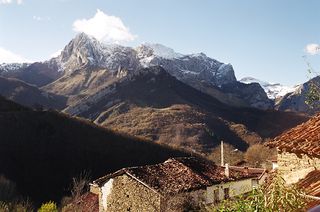
Ponga is a town and municipality in the province and autonomous community of Asturias, northwestern Spain. Its capital is San Juan de Beleño.
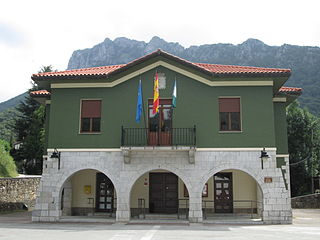
Caso is a municipality in the Spanish Principality of Asturias. It shares a boundary to the North with Piloña; to the East with Ponga; to the South with León and to the West with Sobrescobio and Laviana.

Aller is a municipality in the Autonomous Community of the Principality of Asturias, Spain. It is bordered on the north by Mieres, on the south by the province of León, on the east by Laviana, Caso, and Sobrescobio, and on the west by Lena.

Belmonte de Miranda is a municipality in the Autonomous Community of the Principality of Asturias, Spain. It is bordered on the north by Salas, on the east by Grado, to the south by Somiedo and Teverga, and on the west by Tineo.
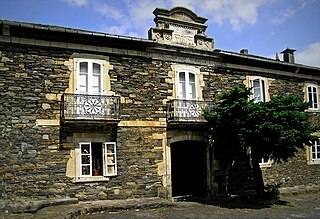
Pesoz is a municipality and the only parish in that municipality in the Autonomous Community of the Principality of Asturias, Spain. It is one of the least populated municipalities in Asturias. It is bordered on the north by Illano, on the south by Grandas de Salime, on the east by Allande and on the west by San Martín de Oscos.
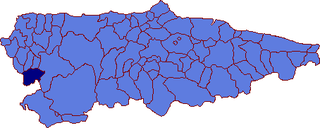
Grandas de Salime is a municipality in the Autonomous Community of the Principality of Asturias, Spain. It is famous for its hydroelectric dam across the Navia River, forming the Embalse de Salime. It is also famous for being a stop along the Camino Primitivo path of the Camino de Santiago, where it is the last stretch of Asturian land before the entrance into Galicia through the Acebo Pass.
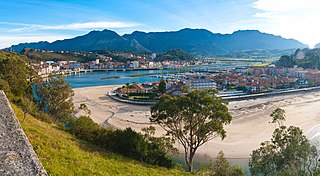
Ribadesella is a small 84-square-kilometre (32 sq mi) municipality in the Autonomous Community of the Principality of Asturias, Spain. Known for its location on the Cantabrian Sea, at the outlet of the River Sella, Ribadesella is a town that forms part of the Picos de Europa. It is bordered on the east by Llanes, on the south by Cangas de Onís and Parres, and on the west by Caravia. Ribadesella is the home town of Queen Letizia of Spain.

Cabranes is a municipality in the autonomous community of Asturias. As of 2023, it had a population of 1,105 spread between its six parishes: Fresnéu, Graméu, Pandenes, Santolaya, Torazu, and Viñón. Cabranes has a rugged, yet not mountainous, terrain, with its economy focused on cattle and apple farming. At just over 38 km2 in area, the municipality is among the smallest in Asturias.
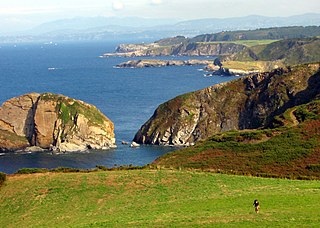
Gozón is a municipality in the Autonomous Community of the Principality of Asturias, Spain. Its capital is the town of Luanco. The Cantabrian Sea lies on its northern edge, and it is bordered to the south by Corvera de Asturias, to the west by Avilés, and to the east by Carreño.
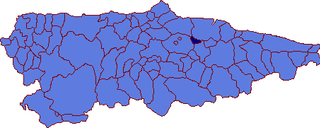
Sariego is a municipality in the Autonomous Community of the Principality of Asturias, Spain. It is bordered on the north by Gijón and Villaviciosa, on the east by Villaviciosa, Nava and Cabranes, on the south by Siero and Nava, and on the west by Siero. The source of the Nora River is within the municipality.
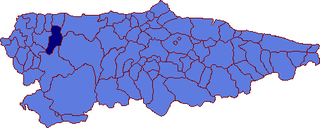
Villayón is a municipality in the Autonomous Community of the Principality of Asturias, Spain. It borders Navia to the north, Cuaña, Boal and Illano to the west, Valdés, Tinéu and Allande to the east and Allande to the south.

Pola de Allande is a town and a parish in Allande, a municipality within the province and autonomous community of Asturias, in northern Spain. It is surrounded by the Cantabrian mountains. It is the capital of the parish. The town was founded between 1262 and 1268. Oviedo, the capital of Asturias, is 104 km (65 mi) away. The Nison River runs through the middle of the town, known for its trout while now fishing is banned there.

Lugones is a parish in Siero, a municipality within the province and autonomous community of Asturias, in northern Spain.
San Emiliano is a parish in Allande, a municipality within the province and autonomous community of Asturias, in northern Spain. It is situated 37 km (23 mi) from the capital, Pola de Allande.
San Martín del Valledor is a parish in Allande, a municipality within the province and autonomous community of Asturias, in northern Spain. It is situated 31 km (19 mi) from the capital, Pola de Allande
Santa Coloma is a parish in Allande, a municipality within the province and autonomous community of Asturias, in northern Spain. It is situated 19 km (12 mi) from the capital, Pola de Allande.

Villaverde is a parish, a municipality within the province and autonomous community of Asturias, in northern Spain. It is situated 11 km (6.8 mi) from the capital, Pola de Allande.

The Pantheon of Asturian Kings is a chapel of Nuestra Señora del Rey Casto in the Cathedral of San Salvador, Oviedo, Spain. It is the burial place of many of the rulers of the medieval kingdoms of Asturias and León.





















